Last Updated on July 6, 2024 by
Badami Cave Temples are rich in their intricately carved sculptures made by carefully cutting rocks. This heritage site in Karnataka should be on the list of tourists.
If you have read my previous article about exploring the heritage sites of Badami, Pattadakal, and Aihole while I was a tourist in Belgaum, I am now writing in detail about Badami cave temples. On my day trip to explore these rich historic sites, Badami was the first place to explore.
Table of Contents
History of Badami Caves Temple Architecture
Badami also known as Vatapi in the earlier centuries was founded by Chalukya King Pulakesi I in the 6th century.
Badami was the capital of the early Chalukyas. The dynasty ruled over the entire Deccan plateau for 200 years. The Chalukya dynasty has been very important to India as they were the patrons of architecture and art.
Although Chalukyan architecture originated in Aihole around the mid-4th century, it extended to the neighbouring villages of Badami and Pattadakal. Their style of architecture is known as a blend of the Indo-Aryan Nagara and Dravidian styles.
The architecture of Badami has the most innovative designs that are mind-boggling. From rock-cut architecture to structural architecture, ornamented with magnificent carvings, rock-cut Badami caves of Karnataka are a must-visit.
Nearly a hundred monuments built by Chalukyas are found in the Malaprabha river basin in the Bagalkot district of northern Karnataka.
The rocks of Badami are sandstones. According to another legend, Badami got its name from the Badam (almond) color of the sandstone.
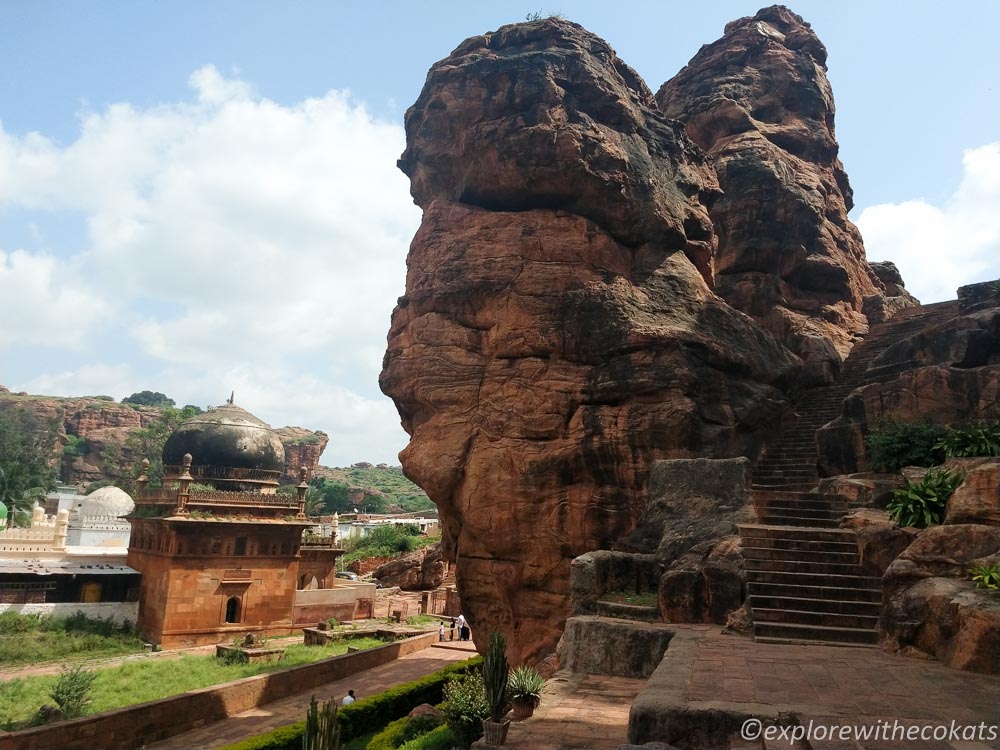
Places to visit in Badami
The entire Badami town paints a pretty picture with the hills, lake, temples, and everything in between.
There are mainly 5 attractions to see in Badami – Cave Temples, Agastya Lake, Bhoothanatha temple, Northern Hill & Badami Fort, and Archeological Museum.
All these attractions are located close to each other and can be covered by walking. To see all of these places in detail, it is best to plan a one-day trip to Badami.
Badami Cave Temples
Visitors arriving by car or by train cannot miss the elevated cliffs that are prominent to the town. An auto-rickshaw from the train or bus station will drop you near the cliffs on the south of Agastya lake. These sandstone cliffs overlook the entire Badami town and the lake.
There are a total of 4 cave temples in Badami. Recently, the fifth cave with 27 rock carvings has been discovered at Badami by a team of archaeologists. While the first three caves are dedicated to the Hindu gods, the last cave is dedicated to Jain deities. Every cave has exquisite carvings done on walls, pillars, and ceilings with motifs and statues of Indian gods and goddesses.
Although Badami caves are temples, worship or offer does not take place here. There is no priest available like in a typical Hindu temple. These are simply heritage monuments.
After parking the car, buy an entry ticket from the counter at the gate and proceed further to climb about 30 steps to reach the first cave at Badami. Each cave is separated by elevation that needs to be climbed with steps. The steps between cave 2 and cave 3 are particularly difficult as they are high.
I could probably write a separate post on the ceiling of Badami caves and walls of Badami caves because each sculpture has a story behind it!
Badami Caves entry fee: INR 25 for Indian Nationals and INR 300 for Foreign Nationals
Badami Cave timings: 9 am to 6 pm
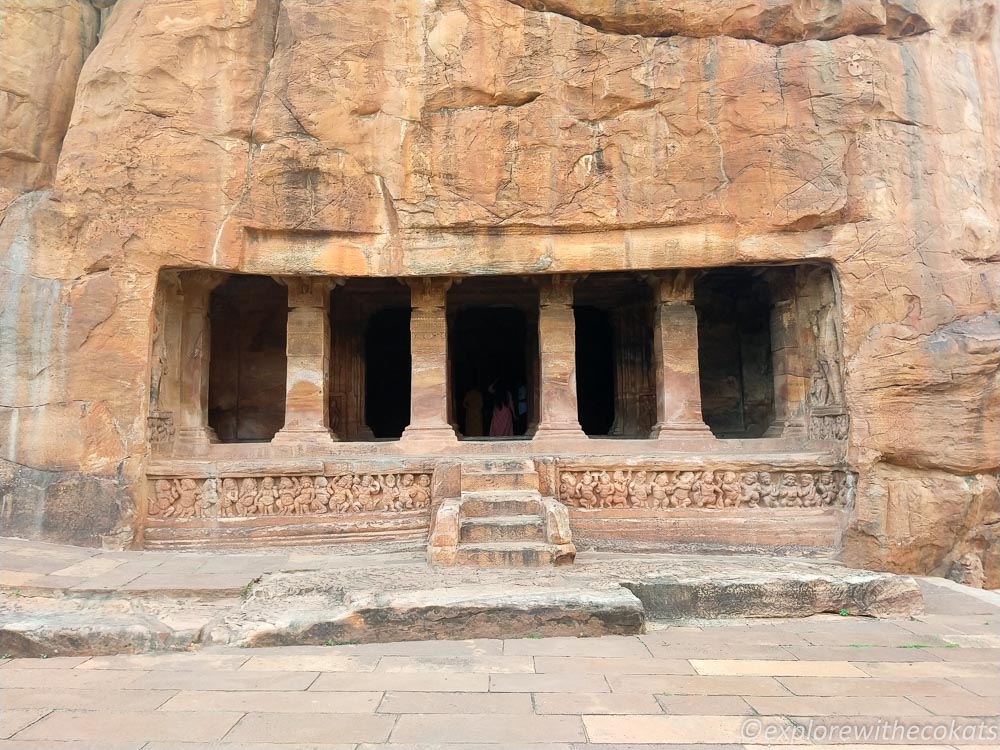
First Cave at Badami temple
The first Badami cave is dedicated to Bhagwan Shiva.
The cave is divided into three parts: a verandah, a pillared hall and a garbhagriha or sanctum sanctorum.
The first and foremost sculpture to capture the eye is the magnificently ornamented 18-armed Nataraja also known as the Dancing Shiva. The pose is said to be striking 81 simultaneous dance poses. I have already visited the Chidambaram Nataraja Temple in Tamil Nadu so watching this pose was extremely special for me.
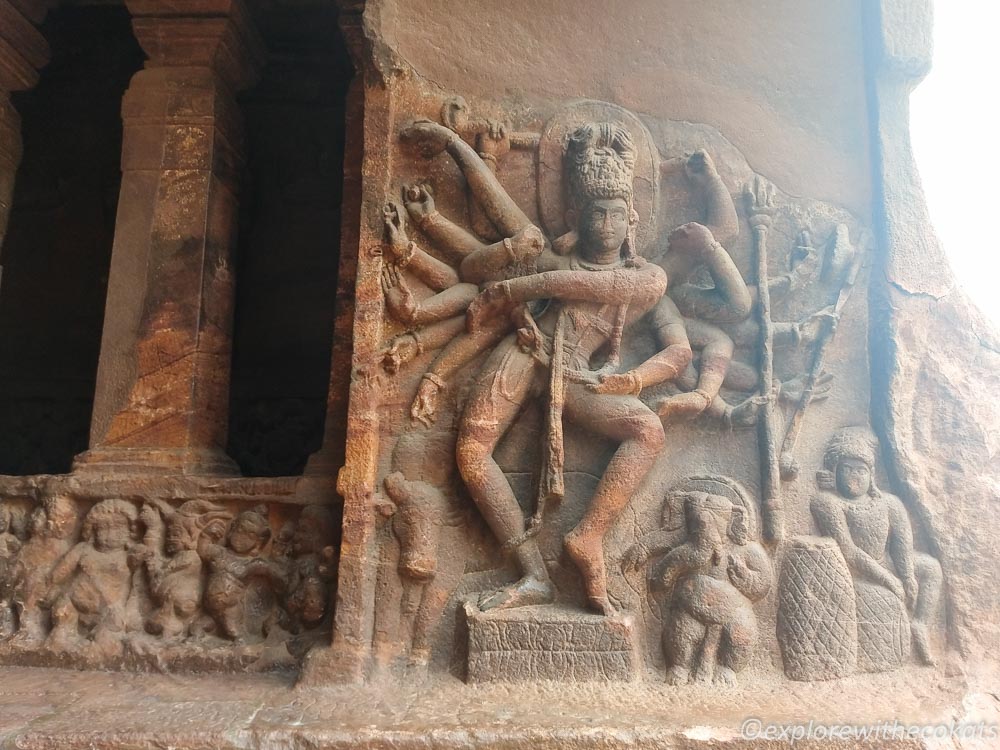
Other important carvings in this cave are a two-handed Ganesha, Mahishasura Mardini (statue of Durga killing the demon Mahishasura), Ardhanarishwara and Shankara Narayana. Ardhanarishwara meaning half-woman lord is the fusion of Bhagwan Shiva and Parvati Devi.
This carving was particularly intriguing because one of the figures having skeletal legs. This carving is of Bhringi, an ancient sage who was cursed by Parvati which is why he lost the muscles in his legs.
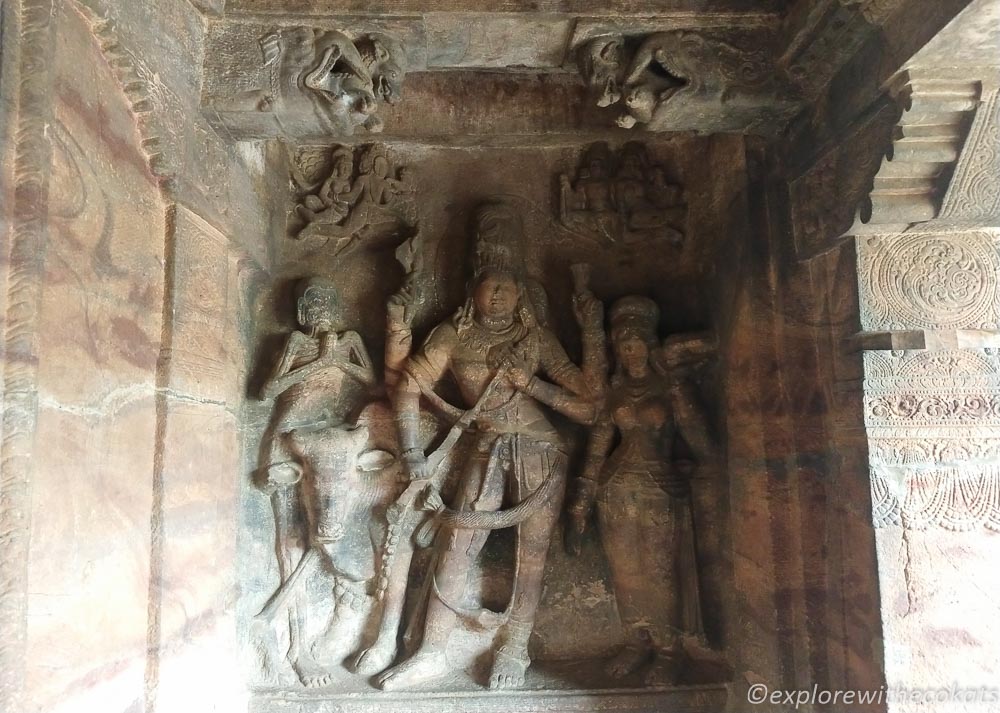
I will probably do a photo story on Badami Cave ceilings as they are sure to leave the visitors stunned with the design and precision of the carvings. A carving that is particularly eye-catching is of the serpent king or Nagaraja.
Once inside the hall of the cave, there is an altar with a Shivling, the phallic emblem of Shiva. A stone representation of Nandi, the bull that served as the god’s mount, is placed in front.
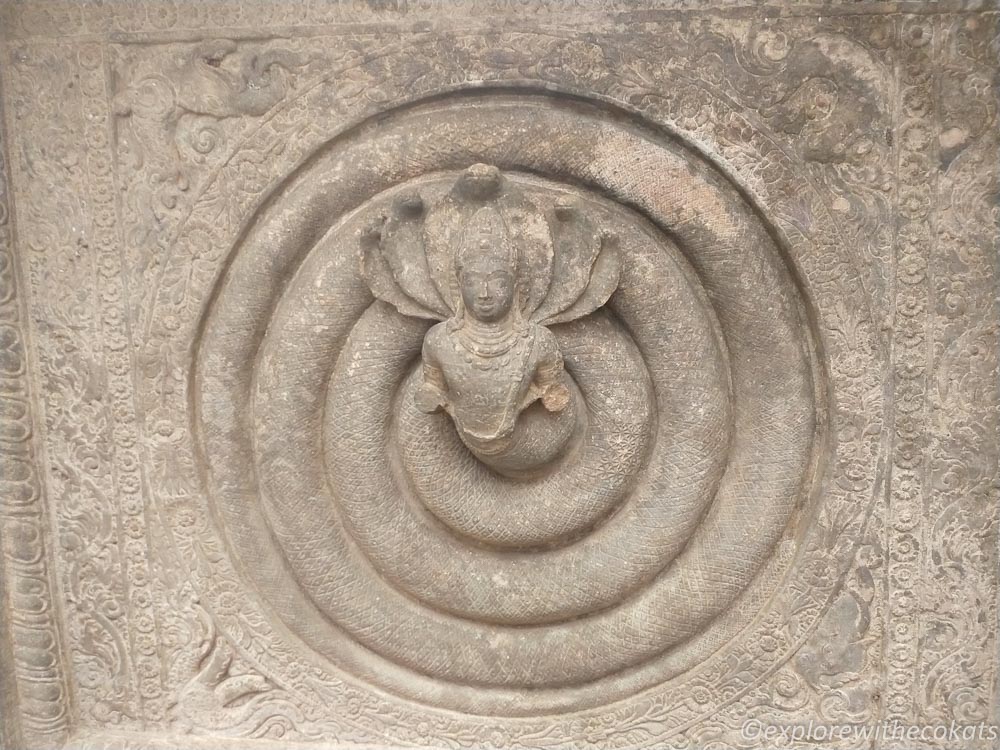
Second cave at Badami temple
Climb around 60 steps to reach the second caves of Badami.
One cannot miss the pot-bellied figures on the cave plinths as one enters the cave. This cave is believed to have been commissioned in the late 6th or early 7th century. It has been sculpted from a boulder that is almost double the height of the first cave temple.
This Badami cave is dedicated to Bhagwan Vishnu and the carvings in this cave are depicted in various forms in magnificent panels carved onto the end walls of the front veranda.
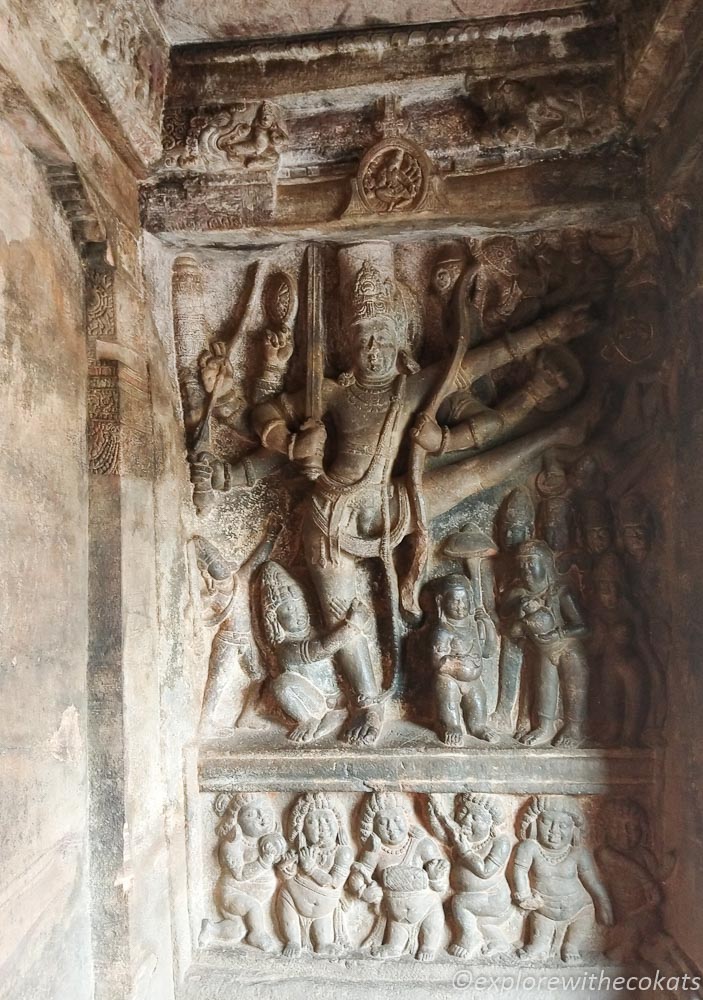
The most eye-dazzling sculpture here is that of Vishnu Bhagwan as Trivikrama. The story behind this sculpture is that Bhagwan Vishnu appeared in the form of Vamana to free the world from Mahabali, a demon king. In the earlier days, any person could seek an offering and the king would grant it.
Similarly, Vamana sought land from the demon king. The land on which he took three steps would be his. The king laughing agreed. Vamana then turned himself into a giant known as Trivikrama and took three steps – one covering the entire Earth, the second covering Heaven, and the third covering the head of Demon King Mahabali thereby pushing him into hell.
On the opposite side is the beautiful sculpture depicting Vishnu Bhagwan in his Varaha (boar) avatar rescuing goddess Earth (Bhudevi) from the depths of the cosmic ocean, with a penitent multi-headed Naga (snake) below.
The ceilings in this cave are extremely delicate. There is a Swastika that has sculptures of couples in courtship, some of them in erotic poses. Another sculpture on the ceiling is 16 fishes as spokes of wheels.
All the Vishnu sculptures reminded me of my visit to Modhera Sun Temple.
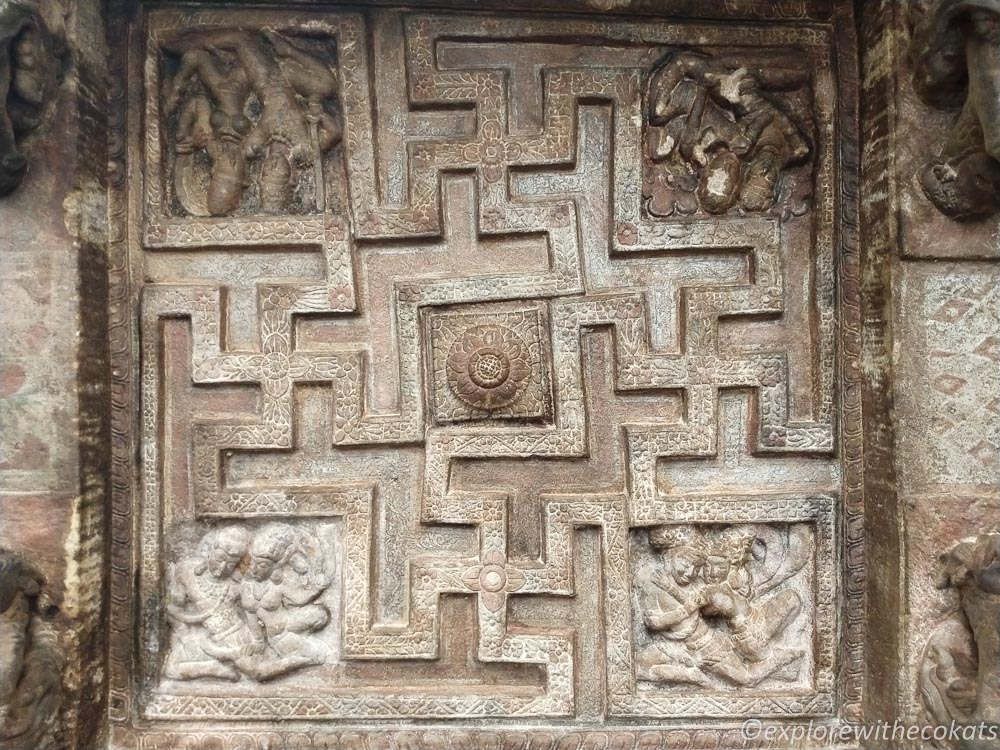
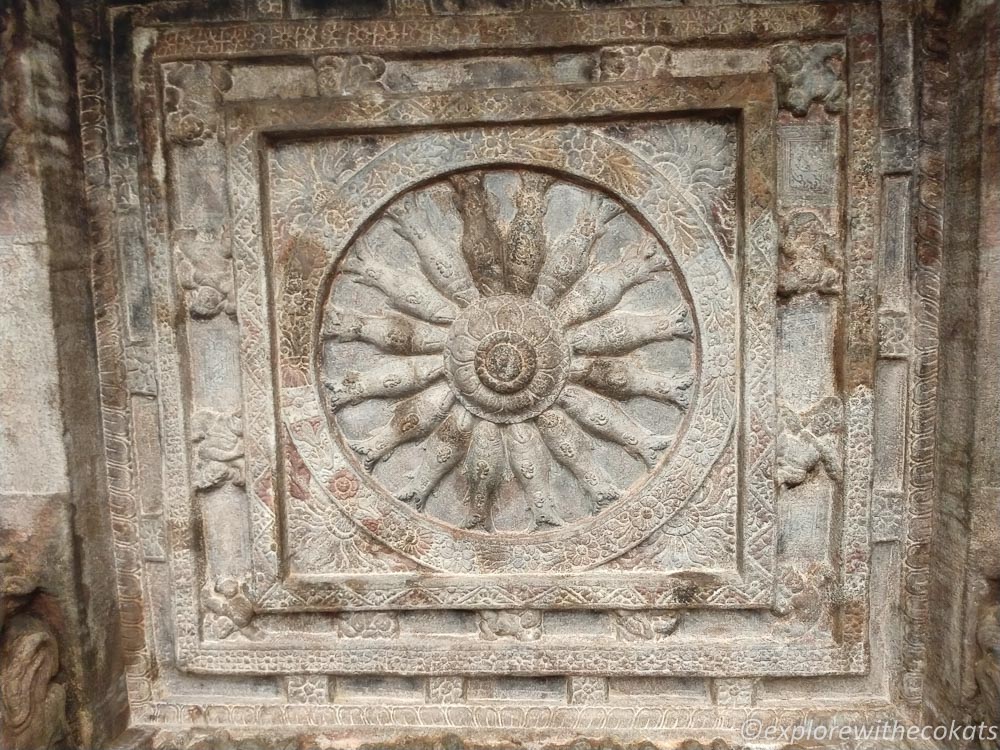
Third cave at Badami
After climbing another 60 steps, facing the beautiful Agastya lake is the third cave. A troop of monkeys welcomed me to this giant cave.
This third Badami cave temple, also dedicated to Vishnu, is the largest and has the most ornamented sculptures of the four caves. Believed to be created in the 5th century, this cave is about 15ft high and supported by 3 rows of six pillars. The cave stands raised on a plinth divided by seven columns. Each of the pillars contains magnificent pieces of art.
This cave has intricately carved friezes and giant figures of Trivikrama, Anantasayana, Vasudeva, Varaha, Harihara, and Narasimha. It also has fresco paintings on the ceiling, which are among the earliest known surviving evidence of fresco painting in Indian art.
Talking about frescos, I highly recommend reading about: Frescos of Tambekar Wada, Vadodara
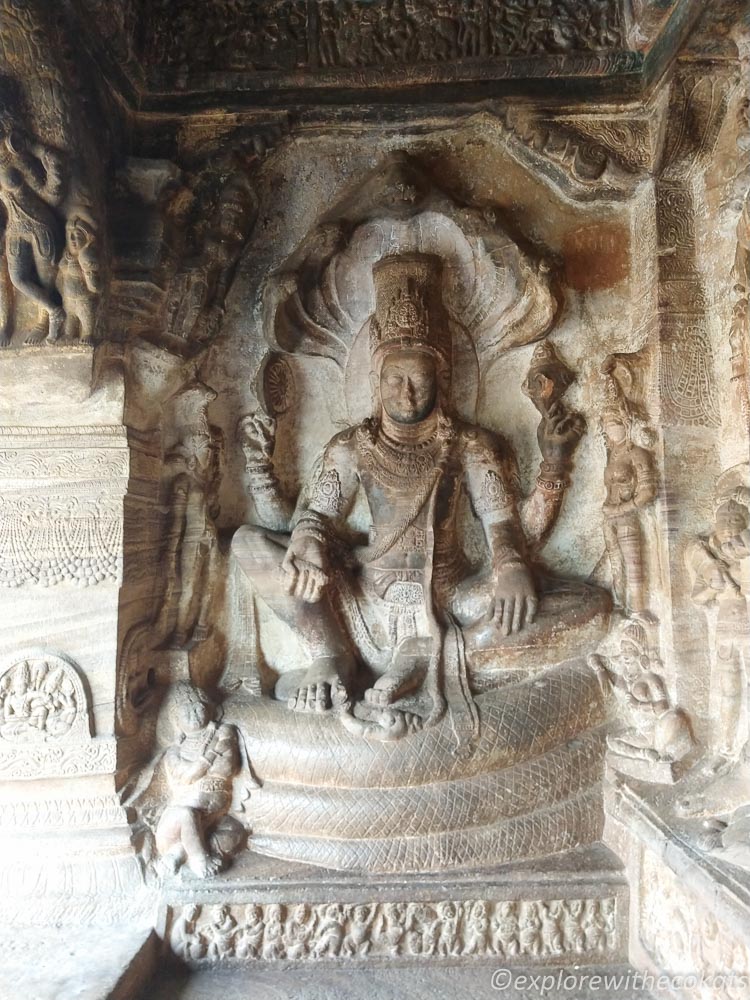
The cave has a large image of Bhagwan Vishnu seated on a coiled cosmic serpent, Adisesha. He also appears in his man-lion incarnation, with the head of a ferocious animal, leaning on a club; and in yet a third appearance the god is with one leg kicked high, pacing out the three steps as Trivikrama just like in the second cave. There are smaller carved images of Indra on his elephant, Brahma on a swan and Shiva riding the bull, on the ceiling.
This cave has angled brackets supporting the beams which are ornamented with sculptures of human couples in erotic postures, posed beneath flowering trees.
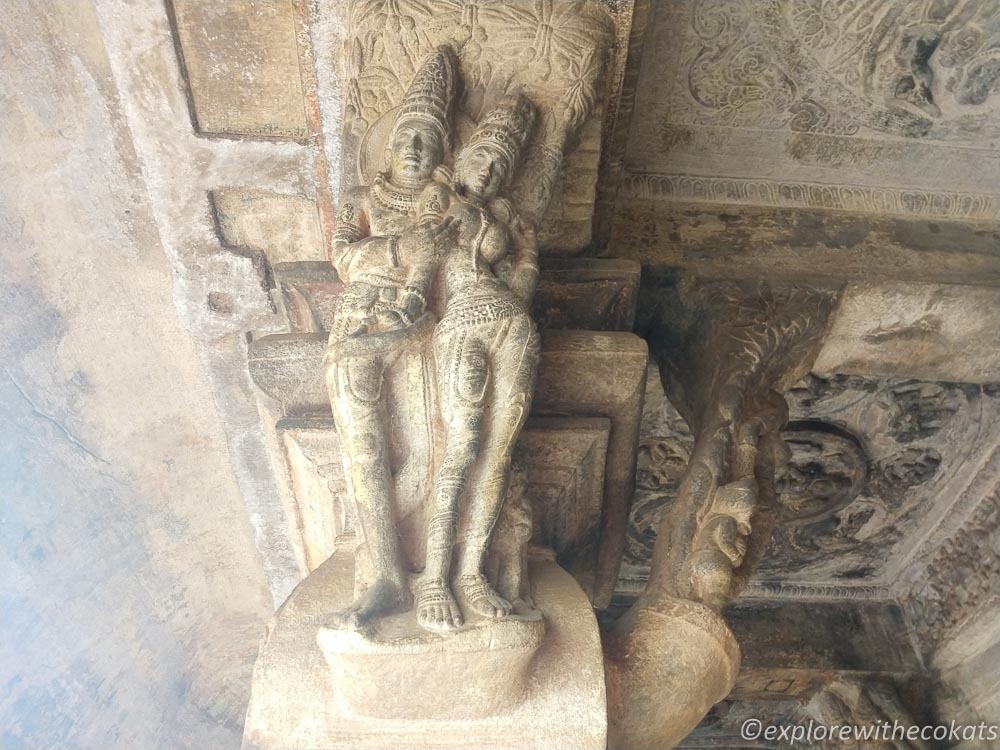
Fourth cave at Badami
The last of the Badami caves is also the smallest.
It is believed to be constructed after the first three caves, in the 7th century. Like the other caves, Cave 4 features detailed carvings and a diverse range of motifs.
Dedicated to the Jain religion, the walls are covered with standing and seated tirthankaras and the sanctum holds a sculpture of Adinath, the first Jain tirthankara.
On entering the cave, on the left, is the sculpture of Bahubali, standing in a meditative posture with vines wrapped around his leg. Bahubali was a prince who attained the stature of a perfected being (siddha).
Although never admitted to the pantheon of twenty-four tirthankaras, he attained jina-like status. The legend of Bahubali tells of a prince who renounces violence after coming close to slaying his brother Bharata in a battle of succession and then renounces pride and its expression – violence to other living creatures.
Embracing ahimsa (nonviolence), he meditates in the “body-abandonment” posture in a forest, where he is entwined by vines and hosts birds that nest in his hair until he attains moksha.
On the right, just opposite the Bahubali image, there is a sculpture of Parshwanath, with a multi-hooded cobra rising over its head.
The carvings on the pillars are different here from the other cave temples. The first row features floral motifs along with circular carvings of amorous couples. The second row of pillars features detailed carvings of Bhagwan Mahavira embedded into a surrounding carving depicting a gate of sorts.
Sunset in Badami from this cave is spectacular if you happen to stay till evening.
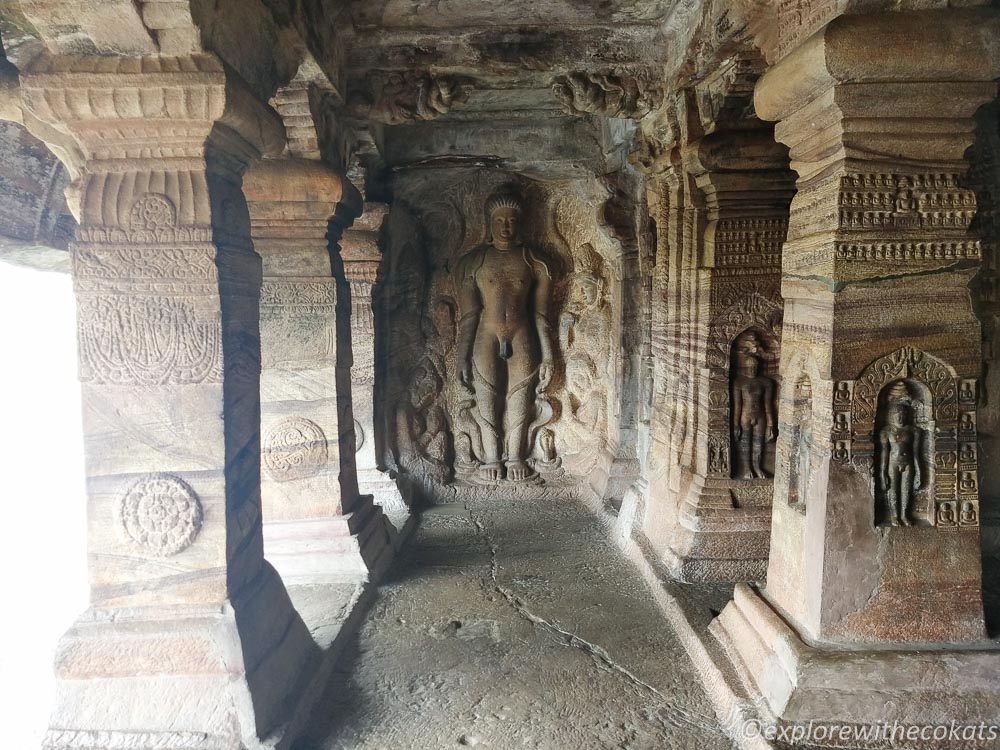
Agastya Lake at Badami
From the courtyards of the third and fourth caves, the crystal clear waters of Agastya Lake are alluring. The lake bank is dotted with Bhoothanatha and Yellamma temples. During the monsoon, the water plunges from a rocky ledge into the tank named after the sage Agastya Muni, who is said to have once meditated by a sacred pond on the cliffs above.
The lake water is believed to have curative powers as it cured the then king’s leprosy.
Although the locals wash clothes and even bathe in them, the parapet around the lake is filled with coloured clothes left for drying. In Spite of this, the lake looks inviting to sit at its bank breathing in the magnificence of architecture.
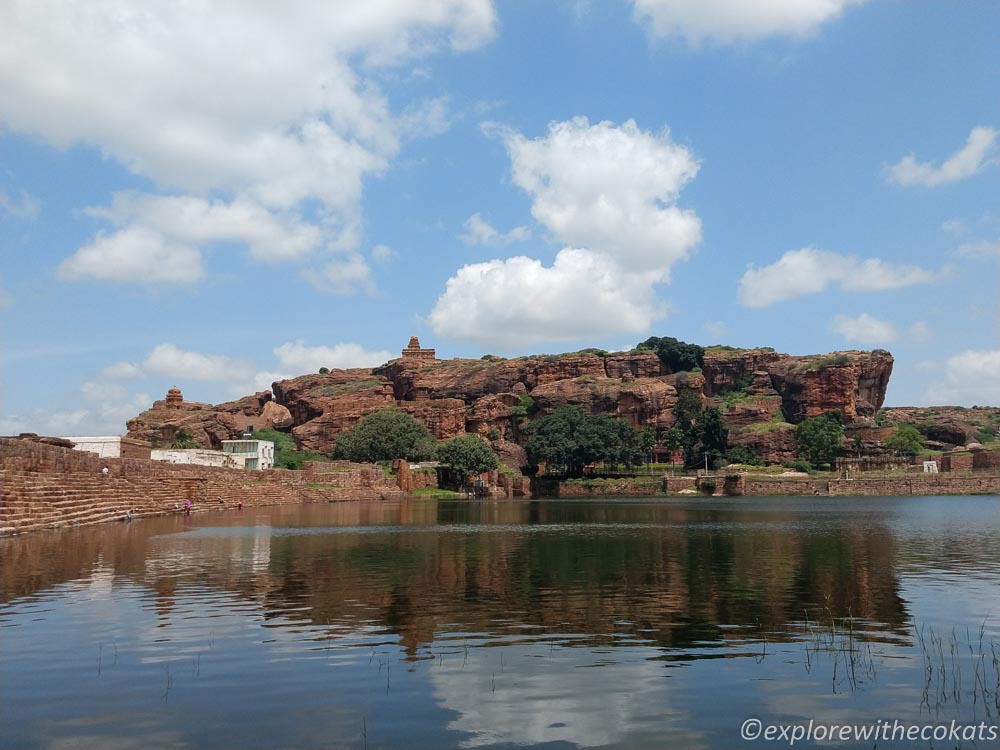
Archeological Museum, Badami
Beyond the caves, past the Agastya Lake stands the Archaeological Museum with beautiful exhibits and relics from the bygone era. It houses a collection of stone sculptures, prehistoric artefacts, art, and inscriptions from Badami, Aihole, and Pattadakal.
The preserved panels of the Krishna Leela are a highlight as they depict scenes from the Ramayana, the Mahabharata, and the Bhagavad Gita.
Timings: 9 am – 5 pm
Entry Fee: INR 10 per person
Bhutanatha group of Temples Badami
At the far end of Agastya Lake, lies the famous Bhoothanatha Temple. It takes around 15-20 minutes to reach the temple by walking from the rock-cut Badami Caves. The location of the temple is very scenic with the large sandstone cliffs forming a stunning backdrop. In monsoon, two waterfalls come alive through the cliffs feeding water to the lake and creating enchanting scenery.
Another temple nearby is the Mallikarjuna Temple not very far from the Bhoothanatha Temple Badami.
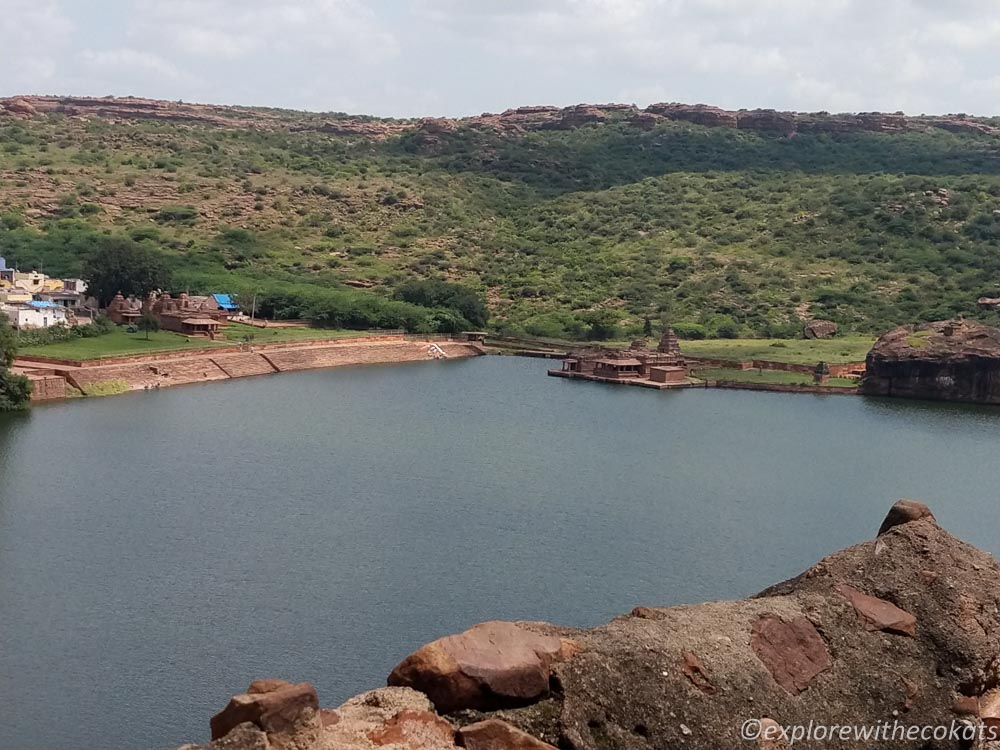
Northern Hill and Badami Fort
Housing the Badami Fort and two ancient temples, Northern Hill is the offbeat place to visit in Badami. A small trek (30-45 minutes) is required to reach the top. It’s a fairly easy trek with well-laid steps between towering sandstone cliffs.
The first temple on the hill is called the Lower Shivalaya and then the temple at the top is called the Upper Shivalaya. There is a circular watchtower, a storeroom for ammunition, and towering rows of granaries near the Upper Shivalaya. Built by Pulakeshi II, a devout Viashnavite, the Upper Shivalaya is capped by a Dravidian pyramidal tower. Stone elephants and lion heads adorn the corner pieces of the temple steps and the outer walls have carvings depicting mythological stories.
How to reach Badami?
By Air
The nearest airport to Badami is Hubli at 105 km and Belgaum at about 150 km. Both are domestic airports that have regular connections to major cities like Delhi, Mumbai, Ahmedabad, Bangalore, and others. Bus, train and even private cars can be hired to reach Badami. The nearest International airport is in Bengaluru.
By Train
Badami station is located 5 km from the Badami caves. Most trains passing through Bengaluru, Bijapur, Hubli, and Solapur are connected to Badami. From the station at Badami, you can board a local bus to reach the bus stand and then hire an auto-rickshaw to reach the hotel or the caves directly.
By Road
Badami is well connected to most major cities and towns in Karnataka. There are state-run Volvo and AC sleeper buses to Badami from Bengaluru, Hubli, Bijapur, Dharwad, and Belgaum to Badami. Self-drive is also possible as there is a fairly good state highway.
Getting around in Badami
There is a lot to see in Badami if you are spending an entire day in Badami. If self-driven, then reaching these places is not a problem. Although most places can be reached on foot, visitors can also hire auto-rickshaws.
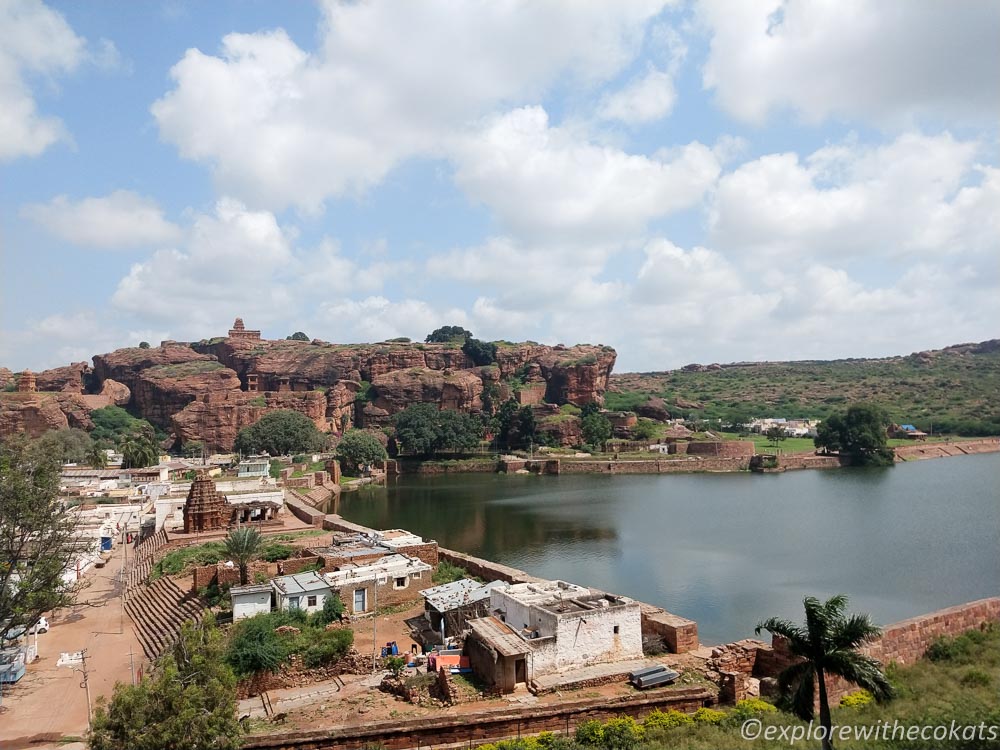
Accommodation in Badami | Where to stay in Badami
If you are reaching by train, then booking a hotel would be required. If you are on the Badami-Aihole-Pattadakal trail then spending a night in Badami is the best option as the Badami town is big in comparison to Aihole and Pattadakal.
There are many hotels in the main town and it is best to book a room in advance. Most accommodation in Badami is in the economical category.
Clarks Inn, Badami is a comfortable option for a couple. Another option is KSTDC Hotel Mayura Chalukya, Badami which is owned by the Karnataka Government. In case a big group wants a comfortable stay then hiring a comfortable villa is the best option.
Agastya Villa has 3 bedrooms with ample space in common areas such as a terrace, verandah, and hall. There is a kitchen to cook or have cooked by a resident cook. This villa can accommodate up to 10 people.
Best time to visit Badami Caves
The best time to visit Badami Caves is in the winters (November – March) as the summers are extremely harsh. Bagalkot district gets less rain so the monsoon season is hot and humid. It becomes very difficult to walk and trek in such uncomfortable weather.
Badami caves open at 9 am and are thronged by one-day trip visitors. If you are spending the night in Badami, it is ideal to explore other places in Badami and then visit the caves post noon. The past noon light also enters the caves and lights up the sculptures that are in the dark during morning hours.
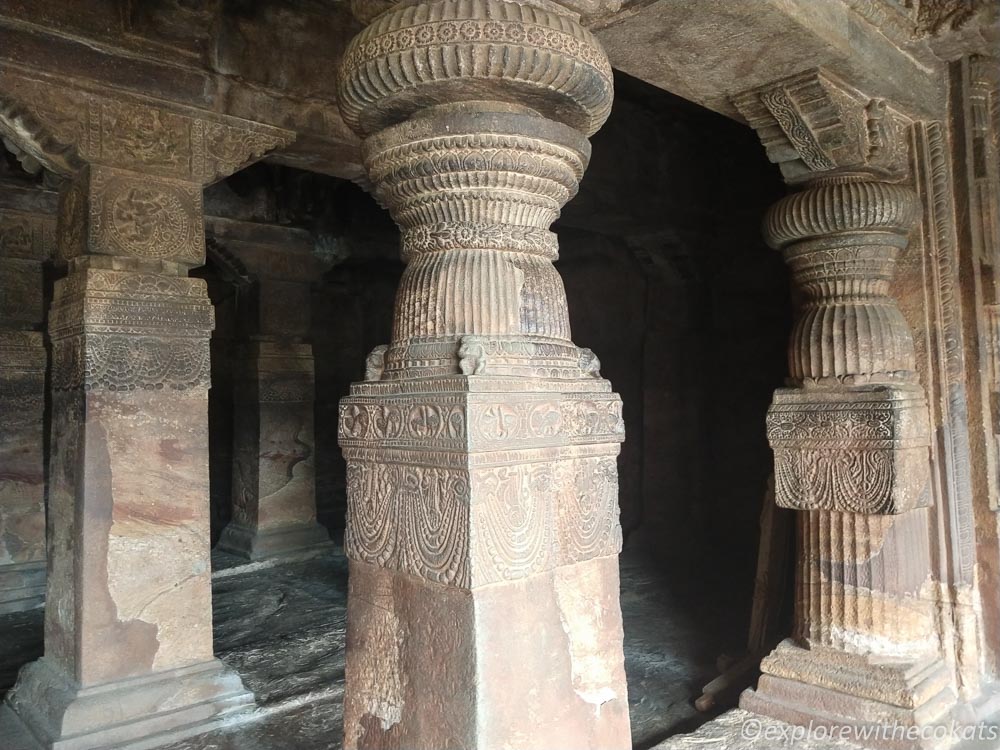
Do’s and Don’ts to plan a trip to Badami cave temples
- Badami town and its nearby areas are extremely hot and humid during the day. I visited in Mid-September which is monsoon and yet it was not pleasant. It is best to carry a cap/hat/stole and sunglasses.
- Wear clothes that are loose, comfortable and sweat absorbing.
- Wear a pair of comfortable footwear as you will climb approximately 200 steps and walk a lot around the tourist attraction in Badami.
- Carry a bottle of water and some snacks for a quick hunger bite. Keep the snacks tucked in a bag so as not to be visible to the resident monkeys. They will snatch it away!
- Paying for Badami entry fees by debit or credit cards comes with a discount as against cash.
- Photography and videography using drones or tripods is strictly prohibited at rock-cut Badami cave temples so do not lug them with you while visiting.
Sustainable tips for Badami cave temples
- Respect the sculptures by not sitting on them.
- Do not harm the sculptures by carving, writing or spitting on it.
- Do not enter places which are closed off, there’s a reason why they are closed.
- Dispose of garbage in the dustbins located at specific points.
- Treat these monuments with respect and do not use them for picnics.
Read More posts from Karnataka
- Aihole – The ancient temple town
- Mahakuta temples of Karnataka
- All about Belgaum
- Things to do in Nirvana Beach, Kumta
- Coracle ride at Talakadu Beach
- Shivanasamudra Falls
Disclaimer – This post contains affiliate links. It means it adds no extra cost to you if you book through the link but I get a referral bonus which helps me earn a little to keep this website up and running.
Pin this post!
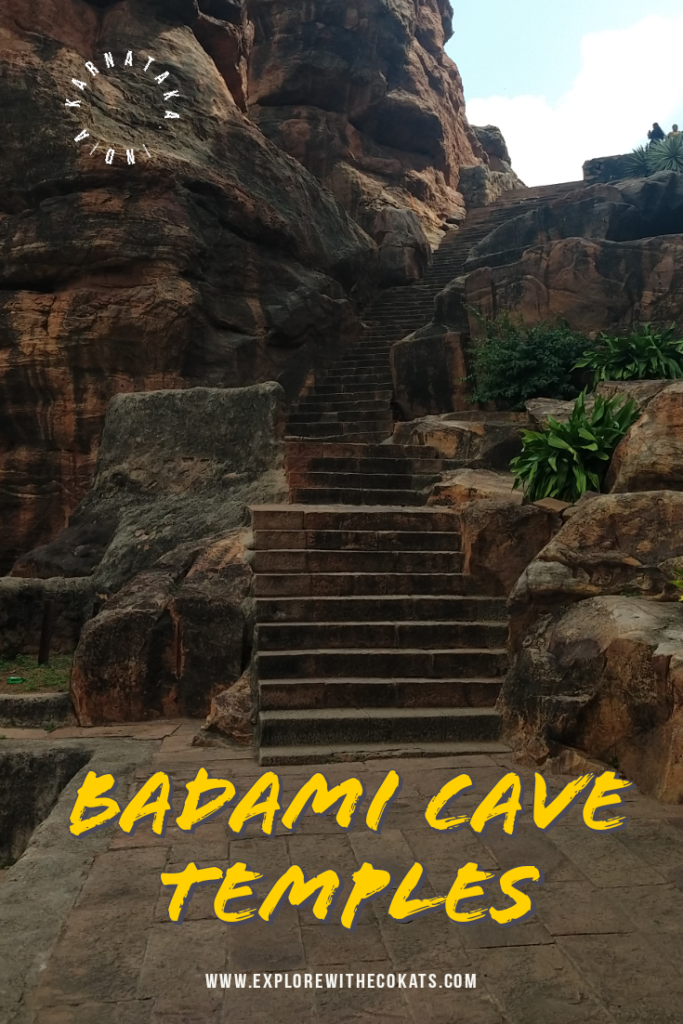

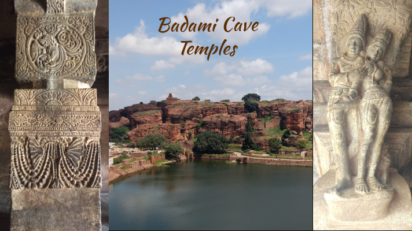
12 comments
Wow this place looks really incredible! I have been itching to visit Karnataka for a while and have to say that your posts make planning a trip there so much easier. Thank you for writing detailed guides like this!
Such hidden gems this country has to offer! In spite of being my birth state, I have hardly visited or explored Karnataka and I am in a bid to change that. Hope you get to go there soon.
How extraordinary and beautiful! A great guide filled with useful information.
Thanks Alma. It was indeed a lovely trip.
Woah, the Badami cave temples are amazing! I love how detailed your guide is and it could easily be used as a historical and cultural frame of reference when visiting. The sculptures are beautiful and I love how they tell a story. I bet the archaeology museum in the area also provides lots of great context. Putting this on the list of places to visit next time we are in India.
You will love it Susanna, you must visit.
Badami and it’s cave temples is not an area I got to when I visited India several years ago. From the information you have shared, this was my loss.
And to imagine I was almost going to pass on this trip, I would have felt the same. Hope you can make it again here next time Joanna.
Great article on the cave temples and useful guide for visitors.
Thank you so much for your appreciative words 🙂
Your photos of the sculptures are gorgeous.
Thanks Terri. The place is absolutely gorgeous!